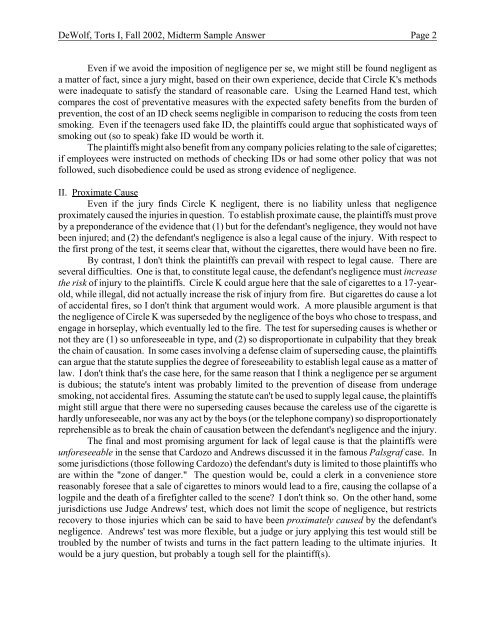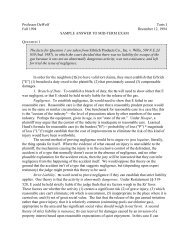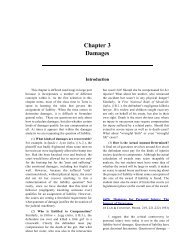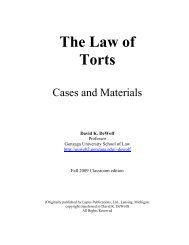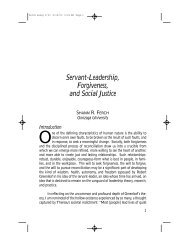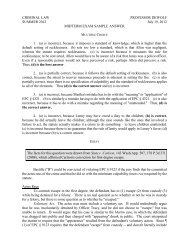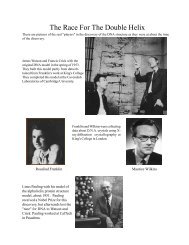were based upon Wawanesa Mutual Ins. Co. v. Matlock, , 60
were based upon Wawanesa Mutual Ins. Co. v. Matlock, , 60
were based upon Wawanesa Mutual Ins. Co. v. Matlock, , 60
Create successful ePaper yourself
Turn your PDF publications into a flip-book with our unique Google optimized e-Paper software.
DeWolf, Torts I, Fall 2002, Midterm Sample Answer Page 2<br />
Even if we avoid the imposition of negligence per se, we might still be found negligent as<br />
a matter of fact, since a jury might, <strong>based</strong> on their own experience, decide that Circle K's methods<br />
<strong>were</strong> inadequate to satisfy the standard of reasonable care. Using the Learned Hand test, which<br />
compares the cost of preventative measures with the expected safety benefits from the burden of<br />
prevention, the cost of an ID check seems negligible in comparison to reducing the costs from teen<br />
smoking. Even if the teenagers used fake ID, the plaintiffs could argue that sophisticated ways of<br />
smoking out (so to speak) fake ID would be worth it.<br />
The plaintiffs might also benefit from any company policies relating to the sale of cigarettes;<br />
if employees <strong>were</strong> instructed on methods of checking IDs or had some other policy that was not<br />
followed, such disobedience could be used as strong evidence of negligence.<br />
II. Proximate Cause<br />
Even if the jury finds Circle K negligent, there is no liability unless that negligence<br />
proximately caused the injuries in question. To establish proximate cause, the plaintiffs must prove<br />
by a preponderance of the evidence that (1) but for the defendant's negligence, they would not have<br />
been injured; and (2) the defendant's negligence is also a legal cause of the injury. With respect to<br />
the first prong of the test, it seems clear that, without the cigarettes, there would have been no fire.<br />
By contrast, I don't think the plaintiffs can prevail with respect to legal cause. There are<br />
several difficulties. One is that, to constitute legal cause, the defendant's negligence must increase<br />
the risk of injury to the plaintiffs. Circle K could argue here that the sale of cigarettes to a 17-yearold,<br />
while illegal, did not actually increase the risk of injury from fire. But cigarettes do cause a lot<br />
of accidental fires, so I don't think that argument would work. A more plausible argument is that<br />
the negligence of Circle K was superseded by the negligence of the boys who chose to trespass, and<br />
engage in horseplay, which eventually led to the fire. The test for superseding causes is whether or<br />
not they are (1) so unforeseeable in type, and (2) so disproportionate in culpability that they break<br />
the chain of causation. In some cases involving a defense claim of superseding cause, the plaintiffs<br />
can argue that the statute supplies the degree of foreseeability to establish legal cause as a matter of<br />
law. I don't think that's the case here, for the same reason that I think a negligence per se argument<br />
is dubious; the statute's intent was probably limited to the prevention of disease from underage<br />
smoking, not accidental fires. Assuming the statute can't be used to supply legal cause, the plaintiffs<br />
might still argue that there <strong>were</strong> no superseding causes because the careless use of the cigarette is<br />
hardly unforeseeable, nor was any act by the boys (or the telephone company) so disproportionately<br />
reprehensible as to break the chain of causation between the defendant's negligence and the injury.<br />
The final and most promising argument for lack of legal cause is that the plaintiffs <strong>were</strong><br />
unforeseeable in the sense that Cardozo and Andrews discussed it in the famous Palsgraf case. In<br />
some jurisdictions (those following Cardozo) the defendant's duty is limited to those plaintiffs who<br />
are within the "zone of danger." The question would be, could a clerk in a convenience store<br />
reasonably foresee that a sale of cigarettes to minors would lead to a fire, causing the collapse of a<br />
logpile and the death of a firefighter called to the scene? I don't think so. On the other hand, some<br />
jurisdictions use Judge Andrews' test, which does not limit the scope of negligence, but restricts<br />
recovery to those injuries which can be said to have been proximately caused by the defendant's<br />
negligence. Andrews' test was more flexible, but a judge or jury applying this test would still be<br />
troubled by the number of twists and turns in the fact pattern leading to the ultimate injuries. It<br />
would be a jury question, but probably a tough sell for the plaintiff(s).


